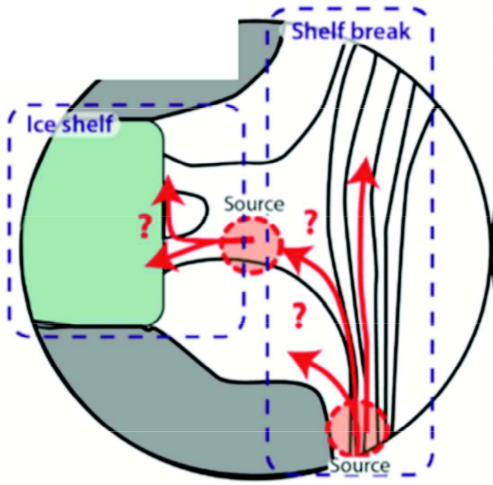The shelf break and the ice shelf front—Two topographic barriers
So far, we’ve explained you that outside the Antarctic continent, warm and saline water (Circumpolar Deep Water, CWD) is located beneath fresh and cold water (Surface Water). We’ve also explained you that if this warm and saline water gets onto the continental shelf and mixes with high salinity shelf water, it melts the ice shelf from below. You think that sound easy? Well, it’s not! The ice shelves are actually pretty well protected from this warm subsurface water…
In Figure 5 from our post on Tuesday you can see that especially the largest ice shelves—Filchner-Ronne and Ross Ice Shelves—are protected from warm water through the continental shelves that keep the warm water at a distance of several hundreds of kilometers. Oceanic currents tend to flow along the bathymetry (slopes), not across it. The continental slope—the steep slope connecting the deep Southern Ocean to the continental shelf— thus acts like a wall and limits the flow of warm water onto the shelf. In the Amundsen and Bellinghausen Sea, however, the warm water already reaches on the continental shelf, and it reaches all the way to the ice shelf front. The ice shelf front reaches many hundreds of meter down into the water, and it forms a second wall that the water has to cross in order to reach the cavities beneath the ice shelves. The pathway of the warm water across these two walls, or topographic barriers as we like to call them, is still poorly understood and therefore the main focus of our project. How does the warm water that is located outside the continental shelf and in a depth of hundreds of meters flow onto the continental shelf and beneath the ice shelf?

Topographic steering
The rotation of the Earth causes ocean currents flow parallel to topographic slopes, i.e. to roughly follow lines of constant depth. The currents around Antarctica therefore follow the continental slope, and water from the slope doesn’t easily make it onto the continental shelf. Similarly, at an ice shelf front currents mainly flow parallel to the front instead of entering the ice shelf cavity. The shelf break and the ice shelf front form a topographic barrier
Warm water has been measured on the continental shelf and beneath ice shelves. In fact, the water can cross topographic barriers after all!
Certain processes help the warm Circumpolar Deep Water to cross the barriers:
- Troughs crosscutting the continental shelf and the shelf break reduce the barrier effect and enable on-shelf transport.
- Eddies formed within the currents are able to move across the “barriers” bringing (warm) water with them.
During our time at the Coriolis platform, we will investigate these points by varying the trough geometries, current thickness and density. If you are interested, please follow our blog throughout the experiments and learn about the control of topography on ocean currents and ice shelf melt!
